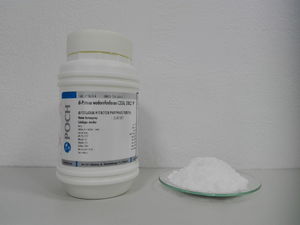Dipotassium phosphate
 Dipotassium phosphate sample and original bottle
| |
| Names | |
|---|---|
| IUPAC names
Potassium hydrogenphosphate
Potassium hydroxidotrioxidophosphate(2−) | |
| Systematic IUPAC name
Potassium hydroxidotrioxidophosphate(2−) | |
| Other names
Dipotassium hydrogen orthophosphate
Dipotassium hydrogen phosphate Dipotassium hydrogenphosphate Dipotassium monohydrogen phosphate Phosphoric acid dipotassium salt Potassium phosphate dibasic Potassium monohydrogen phosphate | |
| Properties | |
| K2HPO4 | |
| Molar mass | 174.2 g/mol |
| Appearance | White solid |
| Odor | Odorless |
| Density | 2.44 g/cm3 |
| Melting point | 465 °C (869 °F; 738 K) (decomposes) |
| Boiling point | Decomposes |
| 149.25 g/100 ml (20 °C) | |
| Solubility | Slightly soluble in ethanol, methanol Insoluble in ethers, hydrocarbons, halocarbons |
| Vapor pressure | ~0 mmHg |
| Acidity (pKa) | 12.4 |
| Hazards | |
| Safety data sheet | Sigma-Aldrich |
| Flash point | Non-flammable |
| Related compounds | |
| Related compounds
|
Monopotassium phosphate Tripotassium phosphate |
| Except where otherwise noted, data are given for materials in their standard state (at 25 °C [77 °F], 100 kPa). | |
| Infobox references | |
Dipotassium phosphate, also called potassium hydrogen phosphate or potassium phosphate dibasic, is one of the potassium salts of phosphoric acid, with the formula K2HPO4.
Contents
Properties
Chemical
Dipotassium phosphate can be converted to tripotassium phosphate by reacting with an equimolar amount of potassium hydroxide.
Physical
Dipotassium phosphate is a colorless crystalline solid, soluble in water, but less so in alcohols. It is odorless.
Availability
Dipotassium phosphate is sold in agricultural stores as fertilizer.
Can also be purchased from chemical suppliers.
Preparation
Can be prepared by adding potassium hydroxide to phosphoric acid in a 2:1 molar ratio, or to monopotassium phosphate in a 1:1 molar ratio:
- 2 KOH + H3PO4 → K2HPO4 + H2O
- KOH + KH2PO4 → K2HPO4 + H2O
The pH of the final solution is tested, to see if the compound has been obtained.
Projects
- Buffering agent
- Make tripotassium phosphate
- Fertilizer
Handling
Safety
Dipotassium phosphate has low toxicity and doesn't require special handling.
Storage
Potassium phosphate dibasic should be kept in closed bottles.
Disposal
No special disposal is required, discard it as you wish.